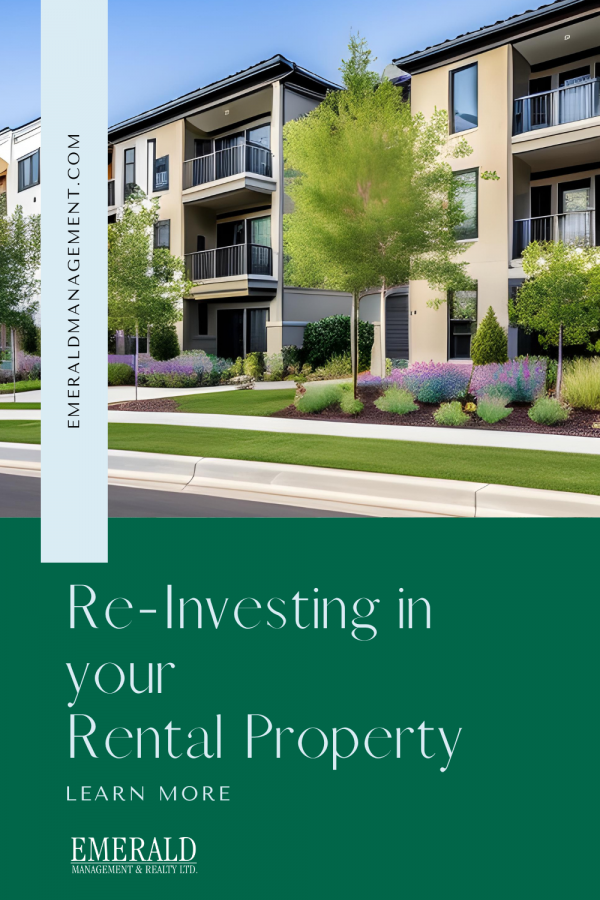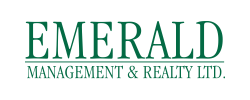 At Emerald Management & Realty Ltd., we take immense pride in delivering exceptional property management services and prioritizing the well-being of your investment. As part of our unwavering commitment to maintaining your property and attracting high-quality tenants, we are currently directing our attention to the essential spring and summer annual exterior maintenance. This comprehensive effort made in collaboration with our clients and in accordance with our management agreement, includes roof inspections, necessary repairs to building exteriors, and meticulous landscaping.
At Emerald Management & Realty Ltd., we take immense pride in delivering exceptional property management services and prioritizing the well-being of your investment. As part of our unwavering commitment to maintaining your property and attracting high-quality tenants, we are currently directing our attention to the essential spring and summer annual exterior maintenance. This comprehensive effort made in collaboration with our clients and in accordance with our management agreement, includes roof inspections, necessary repairs to building exteriors, and meticulous landscaping.
Importance of re-investing back into your rental property
It’s essential to recognize that re-investing back into your property goes beyond tenant satisfaction. It also plays a pivotal role in preserving your property’s value by ensuring that depreciating components endure for the long haul by:
1.Enhancing Tenant Satisfaction:
When you invest in the upkeep and improvement of your property, you create an inviting and well-maintained environment that attracts and retains high-quality tenants. Tenants are more likely to appreciate a property that is aesthetically pleasing, structurally sound, and thoughtfully landscaped. By focusing on spring and summer maintenance projects, such as roof inspections and repairs, exterior enhancements, and meticulous landscaping, you contribute to a positive tenant experience and foster a sense of pride in their living space.
2. Prolonging the Lifespan of Depreciating Components:
Property ownership comes with the inherent challenge of managing the natural wear and tear of various components. Roofs, building exteriors, and landscaping are subject to degradation over time. However, by reinvesting in these areas, you effectively prolong their lifespan and reduce the need for frequent, costly repairs or replacements. Regular inspections and timely repairs to roofs and building exteriors, such as repainting or addressing cracks, help mitigate potential issues before they escalate. Additionally, investing in landscaping upkeep not only enhances the property’s visual appeal but also promotes healthy growth and prevents potential hazards.
Depreciating components and wear-and-tear are further defined by the Residential Tenancy Dispute Resolution Service (“RTDRS”) as the amount of expected wear and tear on a property of time. Essentially, wear-and-tear is defined as the natural occurrence in any property, and tenants are generally not responsible for normal wear-and-tear. This means that tenants cannot be charged for items that have depreciated or exceeded their life expectancy. For example, if you have carpet that is 20 years old and a tenant accidentally causes a stain, you cannot most likely charge them for the cost of replacing the carpet. Depreciation and the aging of property components are part of a landlord’s responsibility to reinvest in the property.
The formula used by the RTDRS when applying depreciation and calculating rewards in a dispute being handled by the RTDRS is:
Age/Expected Useful Life X Replacement Cost = Depreciated Value
For a summary of the expected useful life applicable to the type of property, visit: RDTRS Depreciation Table
3. Safeguarding Property Value:
Real estate investments hold substantial value, and it’s crucial to protect and enhance that value over time. By prioritizing reinvestment into your property, you ensure its long-term appreciation and financial stability. When your property is well-maintained and equipped with updated components, it becomes more attractive to potential buyers or investors in the future. Additionally, an investment property that exhibits a history of consistent upkeep and improvements demonstrates responsible ownership, which further bolsters its value.
4. Maximizing Return on Investment:
Reinvesting back into your property can yield significant returns in the form of increased rental income and reduced vacancies. A well-maintained property attracts tenants who are willing to pay a premium for a comfortable and visually appealing living space. Moreover, by investing in energy-efficient upgrades, such as insulated windows, efficient heating systems, or solar panels, you can reduce utility costs and attract eco-conscious tenants.
Key risks associated with avoiding repairs and preventative maintenance
A significant risk for owners who are reluctant or simply refuse to spend money on repairs is the potential for escalating damages and declining property value.
Here are some key risks associated with neglecting repairs:
- Increased Property Damage: Ignoring necessary repairs can lead to minor issues turning into major problems over time. For instance, a small leak left unaddressed can result in water damage, mold growth, or structural issues. By neglecting repairs, the damage can spread and become more extensive, leading to higher repair costs in the long run.
- Tenant Dissatisfaction and High Turnover: Neglected repairs negatively impact tenant satisfaction. When tenants experience unresolved maintenance issues, it can lead to frustration, inconvenience, and a diminished perception of the property’s quality. Unhappy tenants are more likely to seek alternative housing options, resulting in higher turnover rates and increased vacancy periods. This turnover can be costly in terms of lost rental income and expenses associated with finding new tenants.
- Legal and Liability Concerns: Failure to address necessary repairs can expose owners to legal and liability risks. Inadequate property maintenance may violate local health and safety codes, putting owners at risk of legal consequences, fines, or potential lawsuits from tenants. In the current insurance environment, insurers are also putting more emphasis on preventative maintenance programs and attention to upgrades of depreciating property. Moreover, neglecting repairs can compromise the safety and well-being of tenants, potentially leading to injuries or accidents on the property, for which owners could be held liable.
- Diminished Property Value: A property in disrepair will likely experience a decline in value over time. Prospective buyers or investors may be deterred from purchasing a property that requires substantial repairs or has a history of neglect. Additionally, lenders may be hesitant to provide financing for properties in poor condition. Neglecting repairs can result in a decreased market value and limit the potential return on investment.
- Negative Reputation and Difficulty Attracting Quality Tenants: Word travels quickly in the real estate and property management community, and neglectful owners may develop a negative reputation among tenants, real estate agents, and property management professionals. This reputation can make it challenging to attract quality tenants who seek well-maintained properties. Poor property conditions can also deter potential tenants from applying, reducing the pool of qualified applicants and potentially compromising rental income.
How to deal with wear-and-tear and tenant responsibilities
In Alberta, as in many jurisdictions, it is generally understood that tenants are not responsible for normal wear-and-tear on a rental property. Wear-and-tear refers to the gradual deterioration that occurs over time because of ordinary and reasonable use of the property by tenants. Examples of wear-and-tear include minor scuffs on walls, carpet wear in high-traffic areas, or fading of paint due to sunlight exposure. On the other hand, tenants may be held responsible for damages caused by negligence, misuse, or intentional actions that go beyond ordinary wear-and-tear. These damages typically involve excessive and avoidable harm to the property, such as holes in walls, broken windows, or significant stains on carpets.
Caveat: It is important to be mindful to differentiate tenant caused damages from normal wear-and-tear. While tenants may be responsible for excessive damages resulting from negligence, misuse, or intentional actions, they are not accountable for the natural aging and deterioration of property components. Landlords should assess damages on a case-by-case basis, considering the age and condition of the items in question.
In summary, owners who refuse to invest in or defer necessary repairs put themselves at risk of incurring higher costs, losing tenants, facing legal issues, experiencing declining property value, and struggling to attract quality tenants. Proactive and timely maintenance is crucial to protecting the value of the property, ensuring tenant satisfaction, and minimizing potential risks and expenses in the long term.
Remember, the law generally recognizes that tenants should not be held accountable for the normal wear-and-tear that occurs as a result of their everyday use of the property. By reinvesting in your property, you fulfill your role as a responsible landlord, protecting your investment while providing a comfortable and well-maintained space for your tenants.
Note: It is always advisable to consult the specific regulations and guidelines of your local jurisdiction, including the Residential Tenancies Act or other relevant legislation, to ensure accurate and up-to-date information regarding tenant responsibilities and landlord obligations in your area.
At Emerald Management & Realty Ltd., we understand the value of reinvesting in your investment property. Through our ongoing commitment to exceptional property management services, we prioritize the well-being of your property and its financial success. By focusing on spring and summer maintenance projects, such as roof inspections, exterior repairs, and landscaping, we aim to enhance tenant satisfaction and ensure the longevity of your property’s depreciating components. Investing back into your property not only preserves its value but also maximizes returns and establishes a solid foundation for continued success in the real estate market.
Remember, when you invest in your property, you invest in your future. Let us help you achieve your property’s full potential and secure long-term prosperity. Contact our team today, your property matters to you … and that matters to us!


